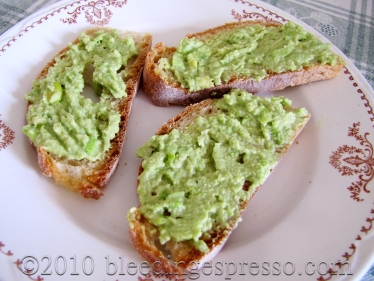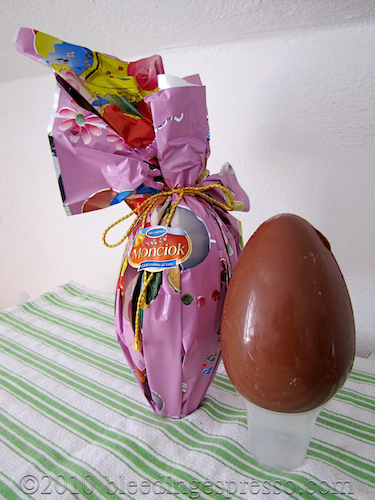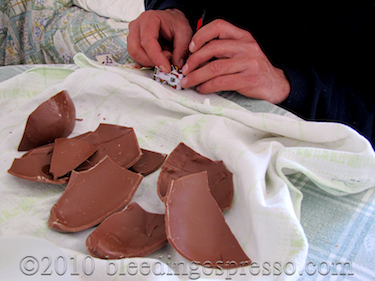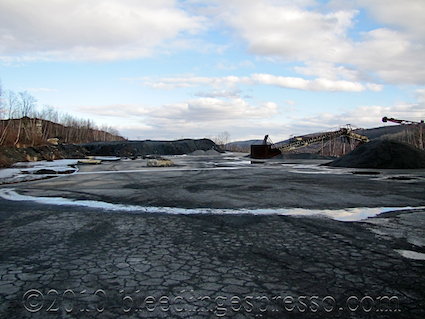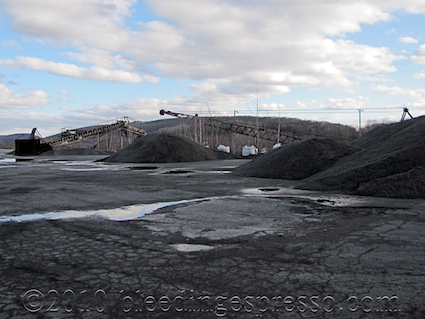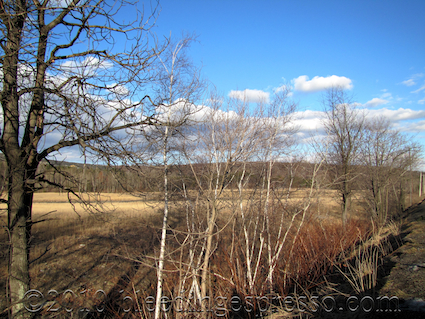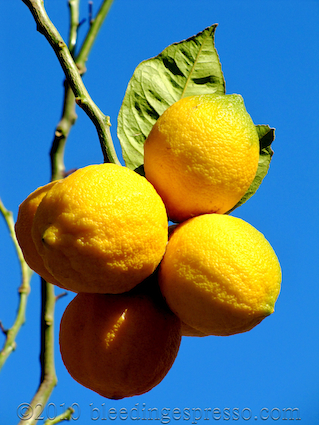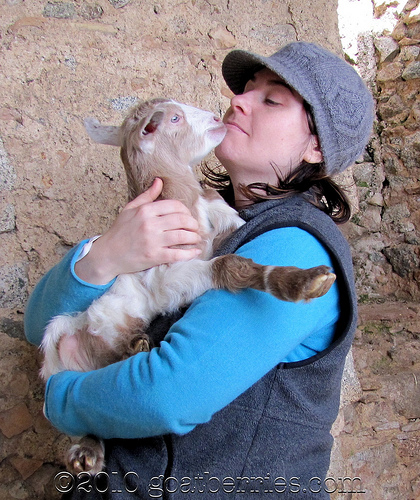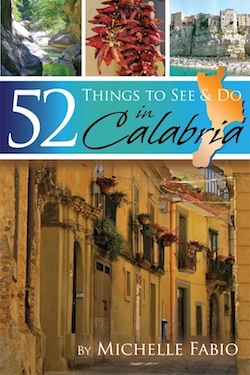Archive for 2010
What’s Cooking Wednesday: Fava Bean Spread
When we get fava beans, we tend to get them by the kilo…several kilos.
We usually just eat them either raw or cooked with Calabrian sausage, but this year I was determined to do something different. Somehow I got the idea in my head to make a fava-based hummus. I love chickpea-based hummus, which I make here despite the lack of tahini, so I gave it a go.
I really enjoyed it, so I’m posting the recipe in case you’d like to try it too.
Some notes before beginning:
- The measurements in this recipe are estimates (although I am usually pretty good at estimating, so do feel safe in using them as general guidelines). Even if I did measure things exactly, though, amounts are going to differ by personal choice, so use your judgment. I trust you!
- This recipe makes enough fava spread for about five slices of bread, the size of which you can see in the photo (each slice sits comfortably in my hand with outstretched fingers). For two people as an appetizer or snack this is a great amount; the mixture probably isn’t going to keep very long in your fridge, so I don’t know how much leftover you really want to make.
- The spread might be even better after sitting for just a little while to let the flavors merge, but I wouldn’t say to leave it more than a day or two. When I make hummus and put it in the fridge, it’s not very appetizing after just two days.
- After I made this, I then looked online for similar recipes. I know. Cart before the horse and all. I see that many blanch their favas before making a spread with it. If you want to do that just give them a dip in boiling water for about 30 seconds and then proceed with the mashing. I think this may be mainly to get the external shell off and make digestion easier, but you can just remove it yourself while they’re raw and keep all the nutrients intact to boot. That’s my recommendation, unless you have particularly hard favas that you think won’t mash well. Judgment time again!
- I added the peanut butter to this recipe because I thought it still needed *something*; if you have tahini, you can certainly try that. You can also try it without the peanut butter or tahini, of course.
- If you play around with this recipe, please let me know. I think it’s a great base spread that can go many different ways, and I’d love to hear your suggestions! This would also be great with some other stuff layered on top or bottom from sardines to ricotta cheese to diced tomatoes. Mmmm.
Fava Bean Spread
- Fresh shelled favas from about 20 medium to large pods
- 1 small clove of garlic, minced
- 3 tablespoons olive oil (just enough to give it some moisture, not make it oily)
- 2 teaspoons peanut butter
- 3 squeezes of lemon juice
- Salt to taste
1. Puree together all ingredients to your desired level of smoothness; I like mine a little chunky.
2. Taste for what’s off/missing and adjust.
3. Spread on toast, fresh bread, crackers, grilled meats, raw veggies, whatever you like!
Buon appetito!
L’Uovo di Pasqua: The Italian Easter Egg
Easter in Italy is generally much less commercialized than in the United States, but there is one tradition that recalls the Easters I knew growing up:
L’uovo di Pasqua. The Italian Easter Egg.
As you can tell from the photo, these are not those little bite-sized, even two or three bite-sized eggs you’re using to seeing. These are hollow and range in size from palm of your hand to ginormous (think: wrap your arms around it to carry it).
I bought some yesterday just to show you what an egg looks like wrapped and unwrapped:
Then since it was open, well, we had to smash it, because the eggs usually have a “sorpresa” (surprise) inside. Depending on how much you paid for your uovo di Pasqua, your surprise could be a dinky little toy or something more substantial, but still a toy nonetheless.
Having spent a whopping €1,50 ($2) on each one of these, we got dinky. And here’s P putting the stickers on the pathetic plastic car:
Stylin’ when it’s done, though, isn’t it? “Collect them all!” says the insert.
And in case you’re wondering, there’s no Easter Bunny and definitely no marshmallow stuff or jelly beans. Thank goodness for my mom! I love jelly beans, and now so does P.
Buona Pasqua to those who are celebrating!
La Settimana Santa (Easter Holy Week) in Calabria
Infinitely more so than Christmas, La Settimana Santa (Holy Week) is the biggest, most important event in Calabria — and it has nothing to do with chocolate bunnies and marshmallow treats (more on that later this week).
Many villages have their own special goings-on, and Badolato is one of them. Activities last all week long and culminate in a half-day procession on Venerdì Santo (Good Friday) and an all day procession on Sabato Santo (Holy Saturday).
Last year, I gathered a collection of my posts on Pasqua in Calabria for you:
There are more stories, photos, videos, and a recipe linked there.
*
I keep struggling with what to call what goes on here, though. “Celebration” and “festivities” simply don’t fit the somber, austere, and deeply emotional mood even for the non-religious like me. This will be my eighth Easter here, and I still get choked up for La Settimana Santa.
The rhythmic beat of a solitary drum echoing through the narrow streets, the bellowing yet wailing voices of men and sometimes women singing about the suffering of their savior, the trudging up these steep, unforgiving hills with the sun beating down on those dressed in layers of robes.
It all begins at the start of the week, with groups of men who walk around the village from church to church each morning leading up to Good Friday. This video was taken this morning from my balcony:
If you can come to Calabria for Holy Week even once in your lifetime, I highly recommend it.
In the Life of an Expat…
In the life of an expat, there are inevitably moments when you’ll miss the place you came from.
Certain holidays and big events top the list, but there are also plenty of small, daily life type things that that make you remember your old life, the people who used to be in it every day, or just “home” itself.
From my experience, those memories are often sparked by smell, which is reportedly your strongest, most reliable sense when it comes to memory. Smell something from when you were five years old and bam! You’re there.
The other day I got a package from my mom full of clothes that hadn’t fit back in my suitcase when I visited a few months ago…and they smelled of her laundry detergent, of course.
*Nostalgia alert!*
The ironic part, though, is that I distinctly remember having a similar experience in America a few weeks into my trip as I sniffed my clothes from here, with *my* laundry detergent smell — enter the pang of missing my life in Italy.
Ah, all in the life of an expat.
A constant push and pull and battle of emotions, contentedness peppered with longing, and happiness churned with sadness, the realization that no matter how consistent and pleasant and wonderful you make your new life (even, for example, if I used the same laundry detergent no matter where I go), there will always be something to remind of you of the other place, the other people, the other life.
It’s quite fitting that while this is one of the hardest parts about being an expat, it’s also one of its greatest blessings.
I know I am ridiculously lucky to have (at least) two places to be nostalgic about.
Buon weekend at tutti!
Peas with Pancetta Plus Divina Cucina’s Secrets from a Tuscan Kitchen Cookbook
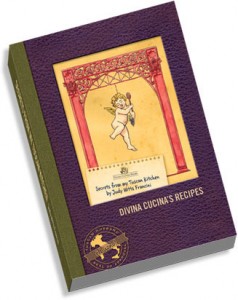 My friend Judy Witts Francini kindly sent me a copy of her handcrafted cookbook, Secrets from My Tuscan Kitchen, and has even more kindly offered to give a lucky Bleeding Espresso reader a chance to win a copy as well.
My friend Judy Witts Francini kindly sent me a copy of her handcrafted cookbook, Secrets from My Tuscan Kitchen, and has even more kindly offered to give a lucky Bleeding Espresso reader a chance to win a copy as well.
To enter the random drawing, all you need to do is comment on this post by 11:59 pm (CET) on Tuesday, March 30, 2010.
Trust me, you’re going to love this cookbook. Not only is it absolutely full of tasty recipes from appetizers to desserts, Judy’s cookbook is also aesthetically pleasing and a cook’s best friend with each page facing the recipes blank so you can add your own notes.
If you don’t know, Italian cooking is very regional, i.e., what you’ll find in Calabria, you probably won’t find in Piemonte, and vice versa. So for those of you who want to get a great taste of what eating in Tuscany is like, you must see Judy’s cookbook, which is based on her own experiences of living in the region for nearly 30 years, particularly as influenced by her Tuscan mother-in-law.
You can read more about Judy’s cookbook and how you can order your own at Judy’s website, Divina Cucina. You can also keep up with Judy at her blog Over a Tuscan Stove and on Twitter @divinacucina.
Of course I wanted to share a recipe with you as I shared Judy’s book this What’s Cooking Wednesday, so I chose something I knew that would be a big hit here. Judy has two recipes for peas in the book, one with pancetta (Piselli alla Fiorentina) and the other with cooked ham (Piselli al Prosciutto); I actually ended up combining the two recipes to adjust for what I had handy (ran out of garlic!), but what I made was closer to Piselli alla Fiorentina, so here you go.
Ah, also, I did leave out the sugar, as P freaks out when he tastes sugar. The peas were definitely sweet enough, and this dish was delicious…and talk about easy peasy! Sorry, couldn’t resist.
Piselli alla Fiorentina
- 1 lb peas
- 2 oz pancetta, cubed
- 1 clove garlic, sliced
- 2 tbs chopped parsley
- 1 tbs sugar
- Salt
- 8 tbs olive oil
1. Place peas, garlic, parsley and olive oil in a saucepan. Add salt to taste.
2. Add enough water to cover peas.
3. Cook over low heat, covered.
4. Just before the peas are done, add the pancetta and sugar. Serve with their sauce.
Buon appetito!
Remember to comment for your chance to a win a copy of Judy’s cookbook!

